WE HAVE
Top Value For You
Sign up for Travelviet VIP membership to enjoy special offers.
Explore the history, culture, people and breathtaking landscape of Vietnam on the Travelviet app
Download the Travelviet app

When mentioning Binh Phuoc, people often remember the vast rubber forests or the wild beauty of nature. However, besides that natural beauty, Binh Phuoc also stands out with historical relics associated with the history of the nation's heroic struggles. Let's explore with 63Stravel the outstanding historical relics of Binh Phuoc through the article below.
Visit 19 long-standing and famous Binh Phuoc historical sites
Following in the footsteps, 63Stravel immediately explores the long-standing historical sites of Binh Phuoc with the list below.
Dong Xoai Victory Site
Dong Xoai Victory Monument is a sacred symbol, erected on the occasion of the 40th anniversary of Dong Xoai's historic victory over the American empire. The work not only engraves glorious victories but also honors the indomitable and heroic spirit of Dong Xoai soldiers and people. With special historical value, this place was recognized as a National Historical Site on December 12, 2014.
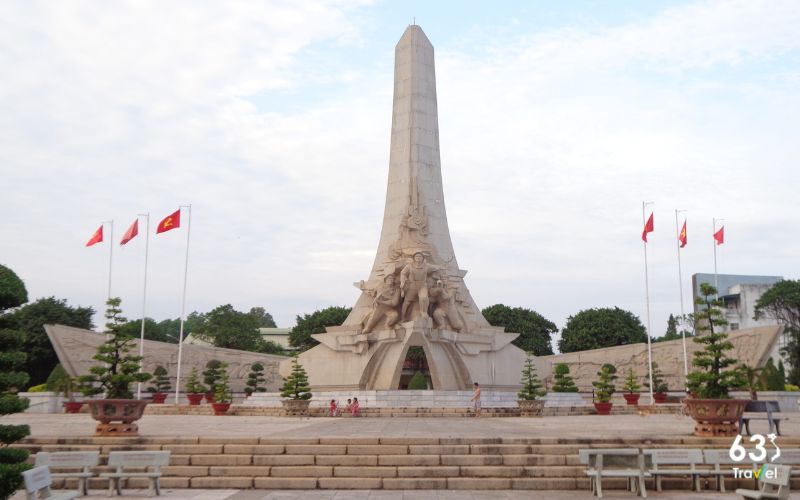
Dong Xoai Victory Monument - a historical relic attracting tourists in Binh Phuoc
The relic area has an area of 16,932.88 m², including many outstanding items such as souvenir galleries, victory monuments, relief paintings, green tree systems and fountains. The most prominent is the 21m high monument, delicately carved from marble, depicting the image of three brave soldiers attacking, symbolizing the heroic spirit of historical days. The two reliefs behind the monument vividly recreate the heroic battle, contributing to creating a solemn but proud space.
The area around the monument is covered with cool green trees and a modern lighting system, turning this place into an attractive destination for tourists every time they set foot in Binh Phuoc. Not only a place to visit, Dong Xoai Victory Monument is also a venue for social events, celebrations, rallies and many meaningful cultural activities, becoming an indispensable part of life. spirit of the local people.
Victory location: O Ship Blockade
The Tau O Block Relic is a majestic historical witness, engraved deeply in the hearts of Binh Phuoc people the glorious victories of our people and soldiers during the most fierce period of the Vietnam War. This place has become a symbol of deep gratitude and gratitude to the soldiers who sacrificed for independence and freedom, when thousands of the country's outstanding sons and daughters fell in this land.
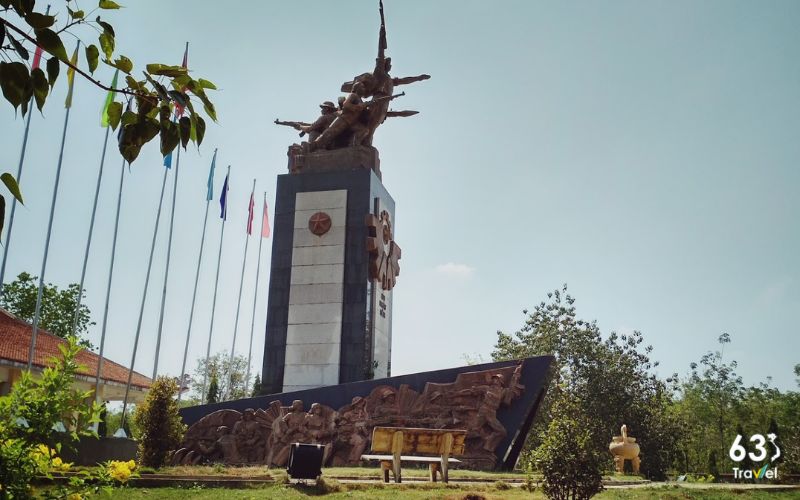
Vessel Blocking Victory Site Relics
The name Tau O originates from the stream of the same name that flows through Highway 13, in Tan Khai commune. During the Nguyen Hue campaign, the Tau O Blocking Point played a key role in the military strategy, when the 7th Division organized a battlefield here to prevent enemy reinforcements from Saigon and firmly protect Loc Ninh district. after being liberated.
Built on an area of 11,451.7m² in 2009, the Vessel Stop Victory Monument includes the Memorial Stele and the Victory Monument, not only a place to commemorate fallen heroes but also a stopping point. meaningful for young generations who want to learn about the nation's history. Each visit here is not only a journey back to the source but also an opportunity to pay tribute to the great sacrifices of our ancestors in the fight to regain freedom.
With profound historical significance, the Tau O Block Relic was ranked as a National Historical Site by the Ministry of Culture, Sports and Tourism in 2012. This place not only attracts history lovers but also gives visitors the feeling of reliving the heroic years of the nation.
Soc Bom Bo
Soc Bom Bo not only offers the opportunity to explore unique cultural beauty but is also a place to preserve the heroic history of the nation. This place is associated with the years of resistance against the US, and is a symbol of the indomitable spirit of the S'Tieng people.
When coming to Soc Bom Bo, visitors will not only listen to emotional historical stories but also have the opportunity to experience the rich cultural life and rich identity of the S'Tieng people, from customs to traditions. daily living activities. This is definitely an interesting destination, bringing both unique historical and cultural values.
Location of establishment of Indochina Communist Party Cell in Phu Rieng
The relic of the establishment of the Indochina Communist Party cell in Phu Rieng is a historical symbol marking an important stage in the revolutionary movement of the Southeast rubber working class. On October 28, 1929, here the Indochina Communist Party Cell (Phu Rieng Cell) was born, with comrade Nguyen Xuan Cu as Secretary, marking the appearance of the first Party organization of the high industry. Vietnamese rubber.
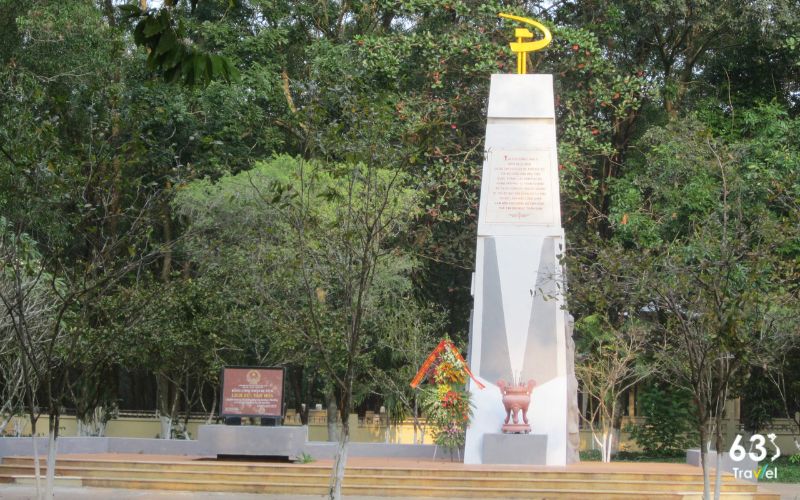
Location of the establishment of the Indochina Communist Party Cell in Phu Rieng - Ranked as a National Monument
Phu Rieng was once a large rubber plantation belonging to the Michelin Company - where thousands of workers were brutally exploited under French colonial rule. Faced with that situation, revolutionary cadres, typically comrade Nguyen Xuan Cu, came here to lead the workers in the struggle. The Phu Rieng cell quickly organized many planned struggles, most notably the strike of 5,000 workers in 1930, creating the famous "Phu Rieng Do" event, greatly contributing to the movement. struggle of the Vietnamese working class.
With great historical value, the relic was recognized as a national historical relic by the Ministry of Culture and Information in 1999. Today, this place is not only a destination to review revolutionary traditions but It is also a pride in the contributions of rubber workers in the cause of national independence. The relic was restored and embellished, becoming a symbol of the strong vitality of Binh Phuoc - the "white gold" land of rubber stretching vast.
>> See more: You must definitely visit 17 tourist destinations in Binh Phuoc that make many people fall in love
Ba Ra Mountain – Mo Waterfall
Ba Ra Mountain - Mo Thac in Binh Phuoc, is one of the three highest mountains in the Southeast region with an altitude of 723m above sea level, outstanding with rugged terrain and associated with many heroic historical events. of the nation. Known not only for its heroic anecdotes, Ba Ra Mountain is also an attractive tourist destination with beautiful natural scenery, including Be River, Me Waterfall, and rich flora.
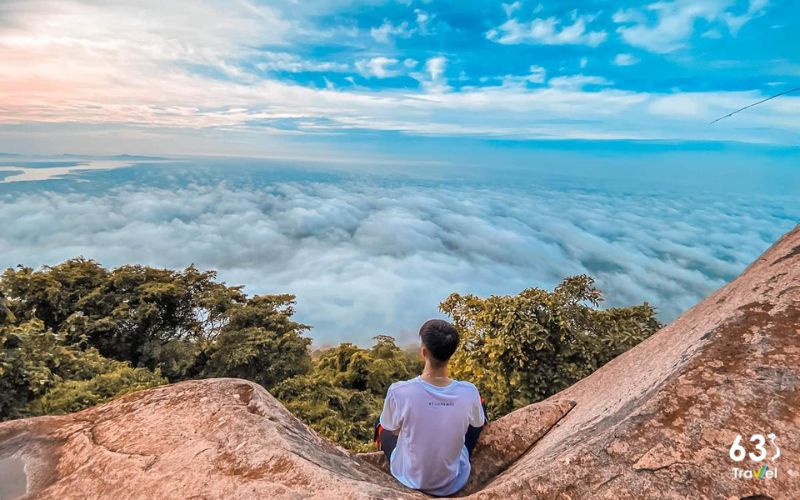
Traveling to Ba Ra Mountain - Mo Waterfall in Binh Phuoc to experience mountain climbing and beautiful scenery
During the period from 1925 to 1941, the French colonialists built at the foot of Ba Ra mountain a large prison with three military camps, where political prisoners and people suspected of being communists were detained. Currently, on the top of the mountain there are still traces of the airport built by the US during the war. Bang Lang Hill area, part of the relic complex, is also where the stele house and temple commemorate the soldiers who died in the resistance war.
For young people who love to explore, trekking Ba Ra Mountain is an experience not to be missed. From the foot of the mountain, you can travel by car or try the cable car journey to admire the panoramic view of the mountain. In addition, Ba Ra Temple (Linh Son Temple), located in the relic complex, is where festivals take place on the 1st-4th days of the third lunar month, attracting a large number of tourists to visit and express their sincerity. glasses.
Historical relic of French colonial rubber garden
The French colonial rubber garden exhibition area is recognized as a provincial-level revolutionary historical relic, a prominent tourist destination of Binh Duong, besides landmarks such as Vinh Phuoc Communal House and Long Hung To Pagoda. This is a place that preserves painful memories of the brutal exploitation that the Vietnamese people suffered during the French colonial period.
At the beginning of the 20th century, the land of Dinh Hiep, Dau Tieng, with favorable climate and soil, became a rubber plantation of Michelin company. Thousands of workers were forced to work in harsh conditions, leading to many rights struggles, most notably the 1933 strike of more than 2,000 rubber workers. This struggle forced the plantation owners to make concessions.
Today, when visiting the ruins, you can see ancient rubber trees and historical artifacts, including rubber workers' houses, latex processing factories, and labor tools. The exhibition area also recreates the daily life scenes of rubber workers, helping visitors better understand their miserable lives.
Vivid images such as a worker tapping latex or a family of rubber workers holding a year-end ceremony make you feel like you're returning to a painful time for the nation. This is also clear evidence of the exploitation that To Huu portrayed through the poem: "Sell your body for a few coins. Flesh and bones are buried under several floors of rubber tree..."
The uprising of the S'tieng people - Phu Rieng commune against the French colonialists
The relic of the uprising of the S'tieng people - Phu Rieng commune against the French colonialists on October 25, 1933, also known as "The West's Grave", is located at Phu Rieng intersection, Phu Rieng district, Binh Phuoc. This is the place that marked an important historical event when the S'tieng people stood up against the cruel rule of the French colonialists.
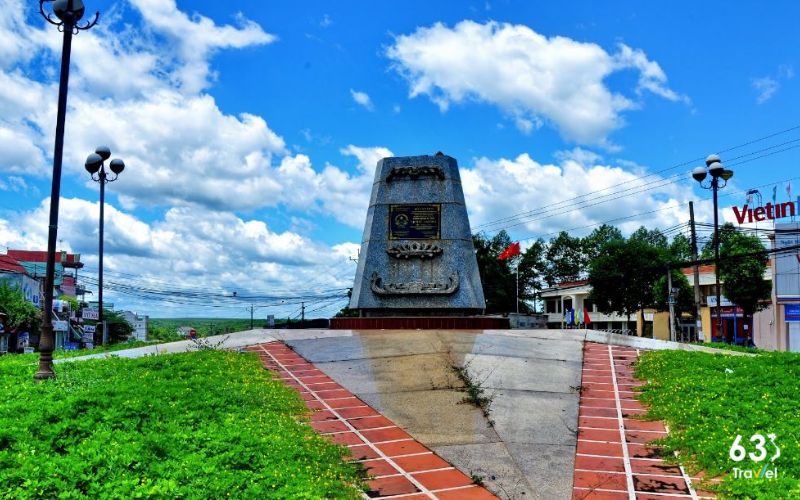
Relics of the Uprising of the S'tieng people - Phu Rieng commune against the French colonialists
In the early 20th century, the French colonialists exploited rubber in Ba Ra district (now in Binh Phuoc), turning this land into a place of torment for indigenous people, especially the S'tieng people. France's brutal policies have exhausted the labor force and destroyed the dignity of the people here, making them unable to endure any more.
On October 25, 1933, under the leadership of two brothers Dieu Mon and Dieu Mot, about 200 S'tieng youth organized an ambush and destroyed District Chief More - the head of the colonial government in the area. . This uprising has become a historical milestone, demonstrating the resilient spirit of the S'tieng people.
After the uprising, the French colonialists set up a memorial stone to commemorate More, but for the Vietnamese people, this was a resounding victory, engraved deeply in the hearts of the Ba Ra people. This uprising not only had great significance to local history but also educated patriotism and the nation's spirit of fighting for independence. On May 29, 1989, this relic was ranked by the Ministry of Culture as a National Historical Monument, recognizing the historical value and indomitable fighting spirit of the S'tieng people.
Phu Loi Binh Duong Prison
Phu Loi Prison is 77,082m² wide and was recognized as a National Historical Site on July 10, 1980. This is one of the largest prisons of the US - Diem regime in the Southeast, operating from 1957 to 1964, and is a testament to the crimes of the US - Puppet government against patriots.
Phu Loi Prison is known as "hell on earth" because of its brutal torture, harsh living conditions and prisoner exploitation policy. Revolutionary soldiers and patriots detained here had to endure all hardships, from lack of food to hard labor. Even so, their patriotism and courage were never defeated.
The prison was renovated from a military base left by France and Japan. After that, the US and the puppet government expanded it into a detention and re-education center, applying brutal suppression measures to destroy the revolutionary forces. The prison architecture includes administrative areas, soldiers' family areas and the detention area "An Tri Vien", with three large camps: Chi Lang, Bach Dang and Dong Da. Each camp has a strict security system with barbed wire fences, solid walls and blockhouses guarded day and night.
Today, Phu Loi prison welcomes many visitors to learn about the history of the struggle of the Vietnamese people. This is a place that preserves the memory of the indomitable patriotism and sacrifice of revolutionary soldiers. Visitors to Binh Duong can combine visits to other relics such as Vinh Loi war zone, Bau Bang victory monument and Phuoc Thanh Provincial Governor's Palace.
Loc Ninh Military Airport
Loc Ninh military airport has an area of 50,000m² and was built by the US and Wei on March 10, 1965. Initially, the airport was assembled with iron grilles (Tec-nich) to serve the supply of food, ammunition and transporting war vehicles to the Loc Ninh area - Cambodia. However, over time, the airport has degraded, only the runway remains.
After Loc Ninh was liberated on April 7, 1972, the airport became a place marking many important historical events. On January 31, 1973, Lieutenant General Tran Van Tra led the military delegation of the Provisional Revolutionary Government to fly to Saigon to attend the first meeting of the Four-Party Military Joint Committee. On February 12, 1973, a ceremony to return 27 American officers, soldiers and military personnel took place here, marking the painful end of a period of war.
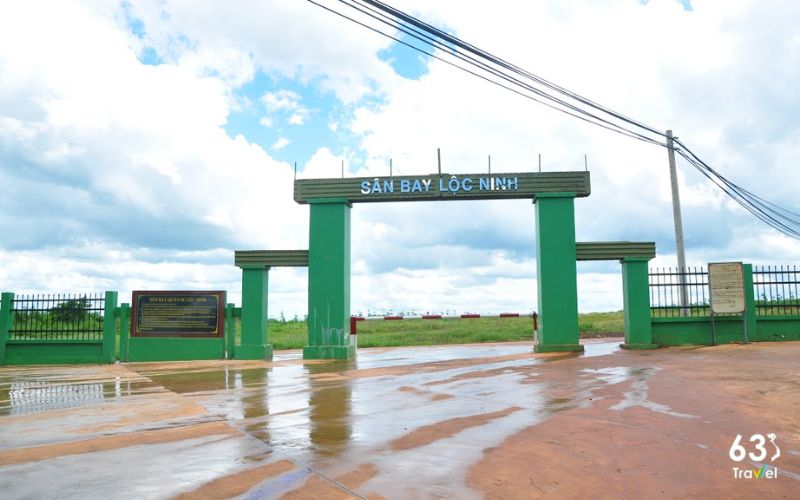
Loc Ninh military airport historical site
During the period from February 12 to March 28, 1973, this airport was one of six locations where prisoners of war were returned, a total of 26,492 people were released. The image of Ms. Vo Thi Thang, a female student who fought for independence, smiling brightly as she stepped off the airport, has become an unforgettable symbol, reminiscent of the unremitting efforts of revolutionary soldiers. .
On September 12, 1973, the airport was also the place to welcome the International Commission delegation and visiting ambassadors and deputy heads of delegations. Today, many tourists, especially Americans, come here to remember the "Loc Ninh of that day", a past that will never fade. Loc Ninh Military Airport was recognized as a national historical relic on December 12, 1986.
Dinh Tan declared
Tan Khai Communal House was recognized as a Provincial Historical Site on August 18, 2014, and is one of the important temples in Binh Phuoc. Built in 1901, the communal house not only worships Thanh Hoang Bon Canh but also commemorates the first colonists who established a hamlet here.
The formation of Tan Khai is associated with 10 households from Tan Khanh - Ba Tra, of which the Huynh and Tran families stand out. They had great contributions in exploring the land before Tan Khai village was officially established in 1912. The name "Tan Khai" means the people from Tan Khanh who came to reclaim the village.
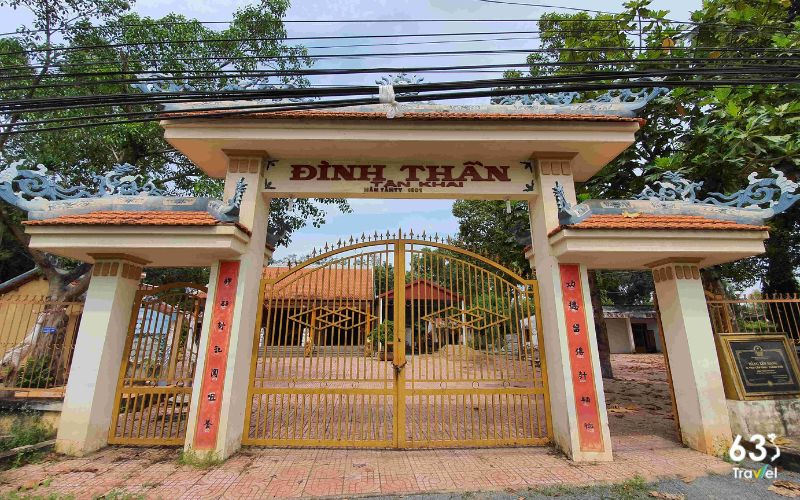
Dinh Tan declared
The architecture of Tan Khai communal house is influenced by Bung Cu communal house - a relic dating back more than 200 years ago in Binh Duong. When the first settlers arrived, they brought culture from Tan Khanh and preserved it to this day. The communal house was completed and the village God Emperor was brought from Bung Cu to worship.
Experiencing many upheavals during the resistance war against the US, Dinh Tan Khai still stands firmly as a historical witness, despite having been relocated 11 times and destroyed many times. Today, the communal house is located on a land area of 2,783m² with many structures such as the Main Hall, Lecture House, and elaborately decorated screens.
The communal house is not only a place of worship but also a cultural center of the community. Major festivals such as Ky Yen Festival (March 18 of the lunar calendar) and Cau Bong Festival (August 18 of the lunar calendar) are held here, praying for peace and prosperity. In particular, the buffalo fighting festival at Tan Khai communal house has a unique feature, where the buffaloes are cared for after fighting and are not sacrificed.
Soc Lon Pagoda
Soc Lon Pagoda is one of the oldest Khmer pagodas in Binh Phuoc province. Construction began in 1931 and inaugurated in 1937. Since 1954, the pagoda has become a cultural and religious center for the Khmer community in Loc Khanh commune.
This place also has a historical mark, having harbored many revolutionary soldiers during the resistance war against France and the United States despite suffering three B52 bombs that caused heavy damage to the main hall. In 2009, the pagoda was restored with a new look but still retains its original beauty.
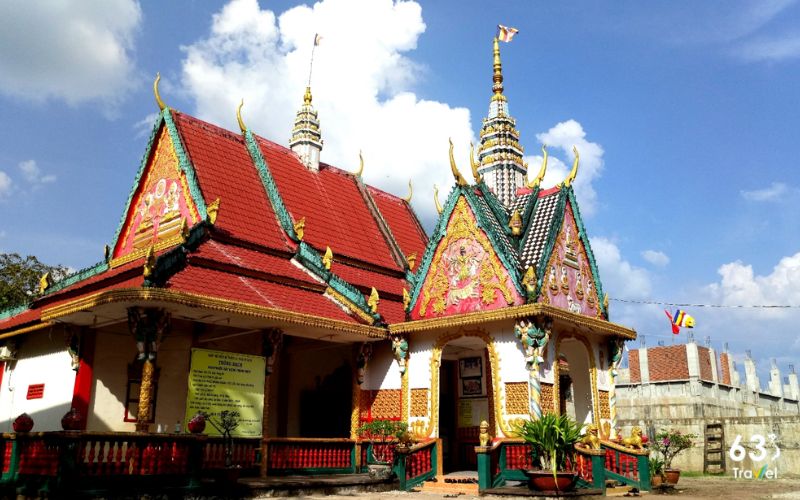
Soc Lon Pagoda, Binh Phuoc, unique Khmer culture
Soc Lon Pagoda represents the traditional architectural style of the Khmer people, mainly worshiping the statue of Buddha Shakyamuni, harmoniously combining landscape and architecture. The temple grounds include the main hall, worship tower, Sala lecture hall and study areas.
The temple gate is exquisitely designed, 3m wide and 5m high, with typical Buddhist motifs. From the gate leading to the meeting house (Sala) is a spacious road, with the Sala built in the East - West direction, where offerings and ceremonial activities take place.
Sala lecture hall has two floors: the ground floor is used as a ceremony house, the upper floor is used as a living room. Outside the Sala, Garuda statues supporting the roof pillars symbolize the strength of unity. The columns are decorated with patterns of deities, expressing solemn beauty.
The pagoda is also a major cultural center, organizing many special festivals such as Lunar New Year, Summer Festival, Dolta Festival and Buddha's Birthday. In addition, volunteer activities regularly take place at the temple. The Bodhi Tower, with its unique pyramidal design, worships the Brahma statue, encouraging people to do good and avoid evil.
>> Should see: 15+ famous historical sites in Binh Duong don't miss
Binh Phuoc Museum
Binh Phuoc Museum is an important center in preserving and promoting cultural heritage. The Museum includes a Board of Directors and four specialized departments: Administration - General, Conservation Operations, Heritage Display and Exploitation, and Museum Operations.
After the impact of the Covid-19 epidemic, the Museum has made efforts to attract children and parents with useful fun activities, encouraging the discovery of historical culture through interesting scientific experiences. More than 4,000 teachers and students have participated in educational programs here, contributing to raising awareness of local history and culture.
The museum is open from 8:00 a.m. to 11:30 a.m. and 1:30 p.m. to 5:00 p.m., creating favorable conditions for visitors. Activities using modern technology such as virtual reality and 3D have enriched the experience, helping viewers clearly feel the value of cultural heritage.
Displays at the Museum focus on two main contents: culture and history of Binh Phuoc. With artifacts reflecting the lives and customs of indigenous peoples, especially the rice offering festival of the M'nong people.
By applying advanced technology, the Museum has created attractive exhibition spaces with clear captions and subtle lighting, bringing a vivid experience to visitors. With more than 15,000 artifacts, Binh Phuoc Museum constantly affirms its role in preserving and promoting the unique cultural values of this land.
Headquarters of the Provisional Revolutionary Government of the Republic of South Vietnam
Loc Ninh - one of the areas that witnessed many fierce battles in history, was once the capital of the Provisional Revolutionary Government of the Republic of South Vietnam (CPCMLTCHMNVN) and the end point of the Ho Chi Minh Trail. On April 7, 1972, Loc Ninh became the first district to be liberated in the South, marking the formation of political and military agencies here, including the House of Exchange, which welcomed delegations. diplomatic.
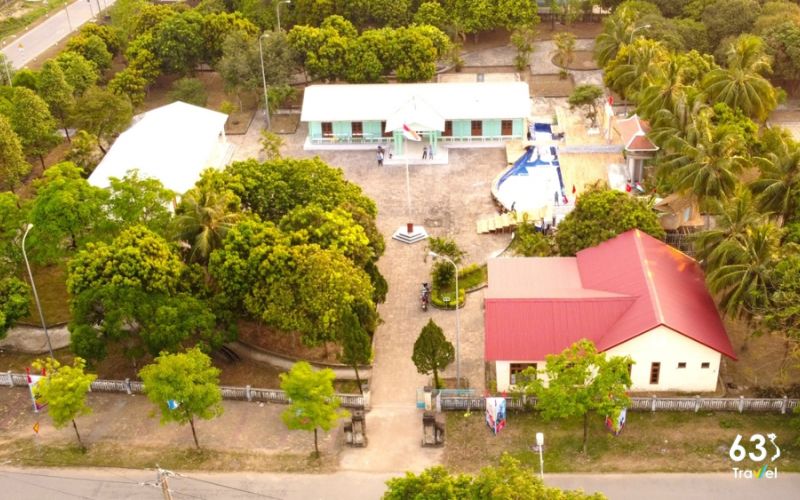
Headquarters of the Provisional Revolutionary Government of the Republic of South Vietnam
Originally, the house was built in 1911 for the French rubber company, which was destroyed during the Nguyen Hue campaign. In March 1973, the CPCMLTCHMNVN decided to build a new headquarters on the old building, with a modern design and diplomatic reception function. The building consists of two floors, the ground floor is made of concrete for meetings and the upper floor is made of wood designed in the style of a reception room.
This was where a four-party military conference took place in 1973, discussing the terms of the Paris Agreement, with the participation of military representatives from the Communist Party of Vietnam, the Republic of Vietnam, the US military and the National Committee of the People's Republic of Vietnam. international. The layout of the conference was like a round table, demonstrating equality between the parties, while also emphasizing the failure of American imperialism in the struggle for independence.
The House of Foreign Affairs is not only a historical relic, but also a symbol of resilience and ingenuity in the fight to protect the country. Recognized as a National Historical Site on December 12, 1986.
Grave of 3,000 An Loc compatriots massacred by the US imperialists on October 3, 1972
The Tombs of 3,000 people relic site in Binh Long Town is a painful testament to the war, marking the great loss of local people. This is not only a famous attraction like Bu Dang Elephant Waterfall but also a mass grave for 3,000 people who died during the Nguyen Hue Campaign period, which lasted for 32 days and nights.
The fierce war between the Southern Liberation Army and the Army of the Republic of Vietnam left thousands dead. After the war ended, the Republic of Vietnam used bulldozers to bury the dead, creating a mass grave. On April 2, 1975, Binh Long was liberated, and on April 1, 1985, the grave site was officially recognized as a cultural and historical relic, engraved with the crimes of the US and Puppet.
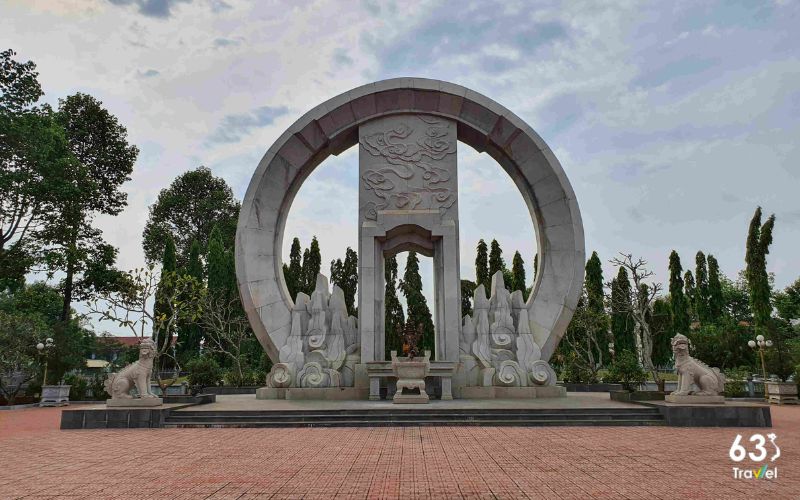
Grave of 3,000 An Loc compatriots massacred by the US imperialists on October 3, 1972
On June 11, 2012, Binh Phuoc province approved a project to renovate the relic site, expressing humanistic significance and educating patriotism. The renovation project officially started on July 1, 2013, with a large scale and a budget of nearly 1,000 billion VND.
The relic area has an area of 4,309 square meters, including many items such as a 12.6 meter high memorial made of natural stone, a large tomb area and works to serve tourists. After visiting, you can continue to explore Standing Waterfall, which offers impressive wild beauty.
Base of the Command of the Liberation Army of South Vietnam
The South Vietnam Liberation Army Command base (also known as Ta Thiet base) is an important historical site in the two resistance wars against the French colonialists and the American imperialists. This place is not only the military base of the Command of the Saigon Liberation Campaign but also plays a key role in the military activities of our army and people, contributing to the glorious victory of the Ho Chi Minh Campaign. .
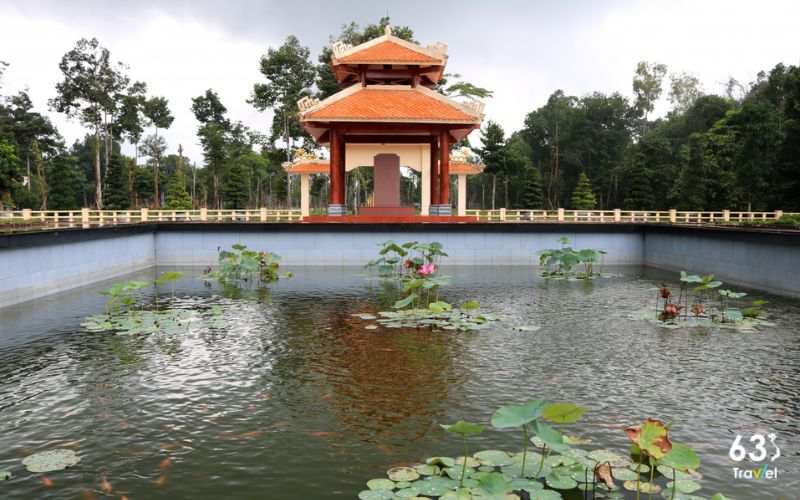
South Vietnam Liberation Army Command Base (Ta Thiet Base)
Known as the "Government Forest," Ta Thiet base is where the Military Commission and Command of the Southern Liberation Force stationed, discussed and planned strategies. After Loc Ninh district was liberated in 1972, this base became the focus of many important military activities.
Before the Ho Chi Minh Campaign in the Spring of 1975, Ta Thiet was built on a large scale with a system of tunnels, trenches and sturdy training areas. You can explore relics such as Giao Ban tunnel, Hoang Cam kitchen and General Tran Van Tra's house. A day here will bring you a lot of useful knowledge about history and patriotism.
VK98 fuel storage tank
VK98 Gasoline Tank - Fuel Warehouse relic is located in Loc Quang commune, Loc Ninh district, Binh Phuoc province, belonging to the special national relic system of Truong Son Road - Ho Chi Minh Road. The warehouse was built in 1974, on an area of 10 hectares around hill 117, with 7 tanks, each tank has a capacity of 250,000 liters, total reserves of up to 1,750,000 liters.
The tanks are made of steel and buried underground, 10m in diameter and 3.5m high, arranged in a triangular shape and protected by forest trees and piles. The pipeline system connecting the tanks allows gasoline to flow naturally, making transportation from VK96 Bu Gia Map station convenient.
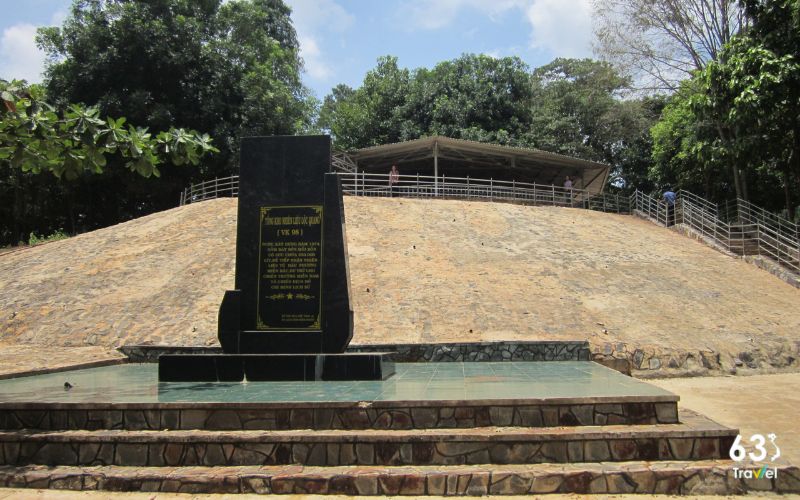
VK98 fuel storage tank
This relic is not only a historical stop but also made its mark in the resistance war, making an important contribution to the Ho Chi Minh Campaign. Today, the VK98 Gas Tank - Fuel Warehouse relic has become a place to learn about the petroleum system during the anti-American period.
With outstanding historical value, the monument was recognized as a national historical site on April 21, 1989. And it was ranked as a special country on December 9, 2013, affirming its important role in the flow of national history.
Cu Lao Rua archaeological site
Cu Lao Rua archaeological relic site, also known as Cu Lao Thanh Hoi. Located between the flow of two branches of Dong Nai river, this monument has an area of 277 hectares and is surrounded by charming river landscape.
Discovered in 1888, Cu Lao Rua is one of the most important archaeological sites in the Southeast. French researchers have excavated and published findings about cultures dating back 3,000 to 3,500 years ago.
Through excavations in the late 20th and early 21st centuries, many relics such as stone tools, pottery and jewelry were found, showing that the ancient people here developed a civilization. rich culture. In particular, products such as curved hoe blades and high-legged ceramic bowls with sophisticated patterns prove that they have advanced manufacturing techniques.
Cu Lao Rua is not only a valuable cultural heritage but also makes an important contribution to the study of prehistoric history and culture of the Southeast region. The findings from the 2003 excavation continue to enrich the treasure of knowledge about ancient cultural history, supporting the economic and cultural development and preservation of Vietnam's cultural heritage.
End point of petroleum pipeline VK96
Relics The end point of the VK96 petroleum pipeline is located in Bu Gia Map commune, Bu Gia Map district, Binh Phuoc province, belonging to the special national relic system of Truong Son - Ho Chi Minh Road. This is an important part of the bridge between the Northern rear and the Southern front line in the resistance war against the US.
From 1968 to 1975, a petroleum pipeline system more than 5,000 km long was formed, meeting essential needs for the war. On March 14, 1975, petroleum arrived at VK96 General Warehouse, from there it was secretly transported to VK98 and VK99 warehouses in Loc Ninh, serving the battlefields, especially during the Ho Chi Minh Campaign. contributed to the victory in liberating the South.
The relic still preserves six gasoline tank burial pits and oil pipelines, located about 500m from the patrol road of Bu Gia Map National Park. The tank burial pits are rectangular, measuring 4-5m in width, 8-12m in length and 1-2m in depth, forming an important petroleum pipeline system for the campaign.
The end of the VK96 pipeline is not only a place to gather petroleum but also marks the silent efforts of Truong Son soldiers and petroleum soldiers in the resistance war. With outstanding historical value, this relic was recognized by the Prime Minister as a special national relic on December 9, 2013.
Betel Garden revolutionary relic area
Vuon Trau revolutionary relic site is located in Dong Ba Ba hamlet, Long Hoa commune, Dau Tieng district, Binh Duong province, about 5 km from Long Hoa commune People's Committee in the direction of Long Tan commune. This is one of the important historical points of the South during the resistance war against the US, along with relics such as Kien An forest and the Ho Chi Minh Campaign Forward Command Post.
Betel Garden was once a strategic base, the place that marked the birth of Phu Loi Battalion, the first armed battalion of Binh Duong province. With 500 officers and soldiers, this battalion made many important contributions during the war, contributing to the victory in the spring of 1975, liberating the South.
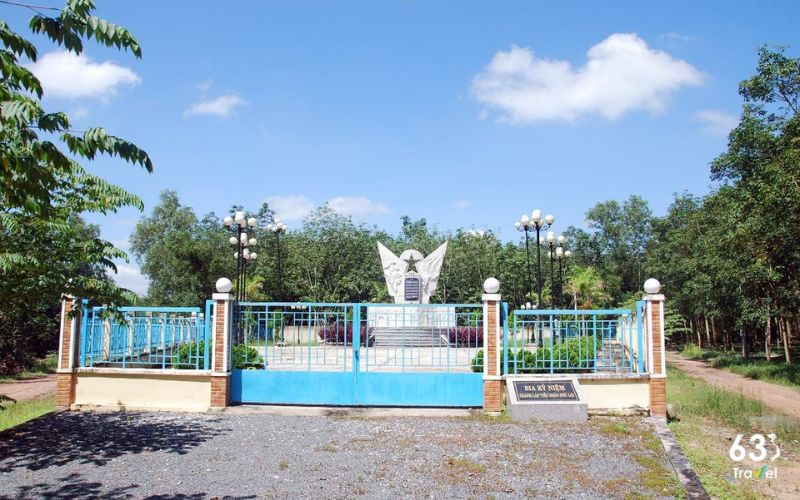
Betel Garden revolutionary base area
Phu Loi Battalion participated in many prominent battles, such as the Dong So battle (December 28, 1964), the victory at Dong Cheo base and the ambush that destroyed the 2nd Battalion of the 8th Regiment on July 8, 2019. 1965, confiscated many weapons and captured dozens of prisoners of war.
For its outstanding victories, Phu Loi Battalion was awarded the title of Hero of the People's Armed Forces on August 30, 1995. On December 17, 2009, the Betel Garden relic site was classified as a provincial historical site and a memorial stele was built to remember the sacrifices and achievements of generations of soldiers, conveying pride. proud to future generations.
Thus, the above article shares information about 19 long-standing and famous Binh Phuoc historical sites that tourists can explore. Please save it if you have the opportunity to visit this land!
Dong Nai 6465 view
Update day : 25/09/2024
Dong Nai is not a tourist land, but it hides in itself an extremely romantic and beautiful natural scenery - Giang Dien waterfall tourist area. The tourist area in Trang Bom district, Dong Nai province, 45km from Ho Chi Minh City center, is a picnic destination chosen by many families and young people every weekend. Giang Dien ecological area complex has an area of up to 67 hectares and is designed into many beautiful works and landscapes that attract tourists every year. In particular, this place is also associated with the legend of the couple's eternal love. Giang Dien Waterfall is formed by three waterfalls: Chang Waterfall, Nang Waterfall and the waterfall itself. Legend has it that, in the past, there was a man and a woman who loved each other but were forbidden and they vowed to die together to fully protect this love. The stream where the two people immersed themselves is Chang waterfall, Nang waterfall today, or people also call it Twin waterfall. Many couples traveling to Dong Nai often come here as if to pray for their love to always be strong. The best thing about coming here is immersing yourself in the cool water at the foot of Giang Dien waterfall. However, you should come here in the dry season to enjoy the cool and calm water because if it is the rainy season, the water flows very fast and carries a lot of silt. In addition to the waterfall, visitors can also visit many other interesting places such as: Hoang Hoa street, Tuyen Lam lake, winter garden, flower hill, love park, Rong house... Let's roam around together to the fullest. Enjoying fresh, relaxing air helps you forget life's troubles. And don't create unique photos for yourself amidst the charming scenery and many beautiful angles like this. With a large space and many attractive entertainment projects, Giang Dien waterfall is an ideal stopover every weekend. Here, you can not only immerse yourself in fresh nature but also experience extremely interesting games. In addition, visitors can also participate in cycling activities or ride a car to explore the eco-tourism area, which is also very interesting. Especially for families with small children, the children's play area here will definitely be a great place for them. The play area space is decorated with many cute and funny images that stimulate children's creativity. The large space is arranged with many games from physical to mental for children to develop comprehensively. If you are a nature lover and enjoy outdoor activities, you can choose to camp overnight at this eco-tourism area. When everything falls into darkness, the whole tent area lights a campfire to socialize, sing... This is a good opportunity to get acquainted and make friends with interesting people. If you are not used to staying in tents, you can also choose a hotel room here. There are many types of rooms with different quality standards for your reference. However, in case you plan to stay in Dong Nai for a long time to visit famous places, you should choose to rent motels or hotels outside to facilitate travel. If you don't know where to go to relax with friends or relatives this weekend, remember to come to Giang Dien waterfall tourist area. The fresh, cool air and beautiful, romantic scenery will make you excited.
Dong Nai 3667 view
From January to December
Mai Waterfall, also known as Bau Nuoc Soi eco-tourism area, is located in Gia Canh commune, Dinh Quan district, Dong Nai province. 130km from Ho Chi Minh City, Dong Nai Mai Waterfall is an ideal destination for travel enthusiasts. Pristine Mai Waterfall is located deep in the primeval forest. Since the beginning, when there was no human intervention, the waterfall area was filled with the white color of wild apricot blossoms, so people named the waterfall after the flower. At Thac Mai, there are large elephant-shaped rocks called "elephant bows" along with stories about the legend of the old elephant still living in the forest that has been passed down orally through many generations of people here. To really conquer the entire waterfall, you should stay overnight so you don't miss out on experiencing the scent of flowers, the wind and enjoying the sweet, fresh taste of forest fruits in the early morning. Mai Waterfall has its own unique beauty in each season, so the waterfall is very beautiful in every season. However, because Thac Mai is located deep in the primeval forest, the dry season is considered the best time to ensure safety during travel. During the period from May to November, the path to Mai Waterfall becomes simpler and easier. However, if you have the opportunity, you should visit Mai Waterfall in spring to see the apricot forest blooming. After arriving at Mai waterfall, you can easily park your car in the area near the restaurant and start your journey to explore this place. If the weather is favorable, don't forget to bring a tent or you can rent a tent to enjoy unique experiences in the forest. Tent rental prices here usually range from 150,000 to 250,000 VND per tent, serving a maximum of 4 people. The best place to camp is near a stream so you can enjoy the sound of running water and the cool feeling of fresh air. However, you can also set up your tent in any location you like, because there are many empty spaces in the forest suitable for setting up tents and holding barbecue parties. The special thing is that this area has never been touched by humans, you will find many interesting things in the forest that cannot be found anywhere else. At Thac Mai, visitors have the opportunity to experience the real life of a Robinson by participating in catching stream fish, catching wild chickens, picking wild fruits and wild mushrooms, then processing them into dishes. Delicious food to enjoy. Until now, the services here are gradually improving. Visitors will be able to walk through the forest and bathe in the stream while still ensuring safety and comfort. The equipment for trekking and cooking is fully prepared, such as a stone stove, forest firewood... so that visitors can experience cooking on their own. Traveling or picnicking at Mai Waterfall is a wonderful experience. To save money, you can prepare food, drinks and a camping tent in advance to organize an interesting BBQ in the evening. If you don't have time to prepare, there will be restaurants in the tourist area that will serve you delicious dishes such as braised fish, hot pot, roasted river beans, chicken dishes and many other specialties. Additionally, on the way back from Thac Mai, just a few hundred meters from La Nga bridge, there is a great wild meat restaurant. Here, you can enjoy specialties such as fish and wild meat at affordable prices. In addition to enjoying delicious dishes, you also have the opportunity to participate in special experiences such as grilling deer, drinking can wine and listening to Chau Ro ethnic music. All of these will create unforgettable memories on your journey. Thac Mai tourist area offers two forms of accommodation for you to rest: you can choose to rent a camping tent to experience the feeling of spending the night in the forest or rent one of the wooden homestays nearby. These homestays are fully furnished and equipped with amenities and are guaranteed to be clean and airy, creating ideal conditions for those who want a more comfortable experience.
Dong Nai 3337 view
From May to November
Buu Long scenic area is considered a precious gift of Dong Nai province and is only about 30km east of Saigon. This place has the beauty of mountains, rivers, lakes, caves,... built up by nature over the years, creating a charming and beautiful scene. That's why people call Buu Long tourist area a miniature Ha Long Bay. Besides natural structures, the tourist area also has a cluster of artificial lakes including two lakes, Long Van and Long An, located next to each other. Along with that are two mountain clusters, Binh Dien and Long Son cave. So when you come here, you can freely explore the most beautiful things similar to the beauty of the world's landscapes. Not only the beauty of nature, religious architectural works bearing the mark of many eras also contribute to the ultimate space of the tourist area. So when you come to Buu Long, you will explore all the different spaces, along with exciting fun activities and enjoy great culinary flavors. Because it is only about 30km from Ho Chi Minh City, you can get to the tourist area by personal vehicle or public transportation. Depending on the actual conditions and location, you choose the vehicle that is most convenient for you. If you depart from Saigon, you can refer to the transportation methods below. Traveling by motorbike or private car: Motorbike is the vehicle chosen by many people because it is both convenient and allows you to experience the feeling of traveling on the roads. Regarding the route, you don't need to worry because Google Maps is with you. By bus: If you take the bus from Ho Chi Minh City, to get to Buu Long tourist area, you need to go through 2 bus stops. Depending on your location, you will take bus number 601, 05 for 15,000 VND/trip. Then take bus number 07, number 09 from Bien Hoa bus station with ticket price 5,000 VND/trip. To get to the tourist area. Coming to Buu Long tourist area, you can go to Co Dau restaurant to experience a luxurious space with a European bias. Or if you love the simple, rustic atmosphere in traditional style, you can go to Du Long restaurant. With the skills of professional chefs, you will definitely enjoy the delicious specialties of Dong Nai. Furthermore, you can check-in and relax in the romantic space of coffee shops right in the tourist area. The tourist area is located at Quarter 4, on Huynh Van Nghe Street, in Buu Long Ward, City. Bien Hoa Dong Nai. Because it is not far from Ho Chi Minh City and operating hours are from 7:00 - 17:00, you can come have fun and return the same day. The weather here has two seasons: rainy and dry, and the most ideal time for you to visit Buu Long tourist area is on sunny days (from December to April of the following year). However, you can rest assured and come here any day because the space here will not deteriorate due to the weather.
Dong Nai 4185 view
From December to April of the following year
Tre Viet tourist village is also known by another name as The Bamboo eco-tourism village, one of the tourist areas near Saigon, only about 15km from the city center. This location has unique architecture, using bamboo trees to express the bold Vietnamese national spirit. The panorama in the Bamboo Viet Village tourist area is designed like a miniature model of the Southern river region. There are full services of entertainment, food, music and relaxation. All promise to bring an irresistible peaceful space to visitors from the first time they arrive. The ideal time to visit Tre Viet tourist village is the dry season from December to March or April of the following year (about 5 - 6 months), because at this time we can participate in experiencing full games. most complete. From the center of Saigon to move to Tre Viet tourist village, you need to run in the direction of District 2 via Cat Lai ferry, continue driving about 400m, then turn onto Phan Van Dang street for about 300m to arrive. Total driving time is only about 30 minutes, very reasonable for picnics or weekend trips. The first thing that people are most impressed with when entering Tre Viet tourist village is probably the super large swimming pool and many interesting games for children there. The clear blue water in the spacious space and separate play area for children are plus points so parents can feel somewhat secure when sending their children here. If you know about basket boat rowing in Bay Mau coconut forest in Hoi An, you definitely have to try it at Tre Viet tourist village. Basket boats have been a means of transportation for people on the sea and rivers since ancient times. The first time you experience rowing a basket boat, many of you will not be familiar with it, but we can rest assured that Tre Viet tourist village is fully equipped with life jackets and has staff on duty to ensure the safety of players. Regarding dining, the buffet counter design at Tre Viet tourist village is inspired by traditional Vietnamese culture. Furthermore, 60 traditional delicacies are also prepared and beautifully decorated, including: grilled chicken, roasted pork with rice paper, grilled shrimp, boiled meat wrapped in rice paper... Delicious dishes from salty to sweet make us overwhelmed and impressed. Like standing in front of a busy countryside market.
Dong Nai 3575 view
From January to December
Scorpio Vang tourist area is located on an area of more than 8 hectares, featuring a fresh and green natural space. It offers many fun water games, challenging land games, and organizes many team building activities to bond everyone. Visitors can participate in camping, build campfires, enjoy unique local cuisine, and attend conferences or outdoor events with family and companies. With more than 20 years of construction and development, Bo Cap Vang has become a favorite destination for many tourists when visiting Nhon Trach, Dong Nai. Bo Vang thanks to its convenient location, only 30km from the center of Ho Chi Minh City, this tourist area is always the top choice for those who want to find a place to relax, play and camp near Saigon. to relax your mind after stressful days of studying and working. Youth is the most beautiful time, don't let it pass by regrettably. Spend a few days with your family and friends to experience new things at Scorpio Vang. When you look back at the happy memories with your loved ones, you will realize that all the efforts and this journey were worth it. Scorpio Vang with 8 hectares of perennial green trees and the surrounding Ong Keo river, creates The green and peaceful space is rare to find anywhere else. Coming here, you will: Breathe fresh air, immerse yourself in nature. Listen to the sound of the wind whispering in your ears, gently dispelling your worries. Enjoy the relaxation and peace that everyone is looking for. Scorpion Vang is an ideal destination to get away from the hustle and bustle of the city and find peace of mind. Scorpion Vang tourist area is one of the top destinations for eco-tourism near Saigon, with many Young people, groups of friends, families and companies choose for their vacations and entertainment. Temporarily put aside stressful days of studying at school or busy work at the office, come to Scorpio Vang to experience the airy natural space. Participating in fun games and enjoying country cuisine will bring you relaxing and enjoyable moments. Scorpio Vang tourist area offers diverse experiences with interesting land games: from trampoline jumping, archery, dart throwing to soccer, bull riding and driving the Squad off-road vehicle through the forest. Intellectual game areas such as checkers, Chinese chess, checkers, bowls and stilts help relax and train dexterity, while teambuilding games help strengthen team spirit. Scorpion Vang also provides equipment for tug-of-war games, water returning to the source, sack jumping and piggy bank blindfolded games (20,000 VND/pig). Scorpion Vang tourist area is attractive with many water games. such as continuous floats, sausage floats, paddle boats, electric boats, slides and speedboats. Visitors can experience free games such as the monkey bridge, handball, rowing boat racing and fishing. Camping and campfires at Bo Cap Vang provide an exciting experience for those who love nature. You will immerse yourself in the cool green space, enjoy the sounds of flowing water and singing birds, creating a relaxing atmosphere. This activity helps practice life skills and teamwork when sharing work. A night camping at Scorpion Vang will definitely leave beautiful memories of friendship and nature. Scorpion Vang is considered an ideal location to organize outdoor events, customer conferences, birthdays, etc. exhibitions, weddings, year-end parties with an airy space full of natural vitality. Scorpio Vang's extremely professional and experienced staff is always ready to assist customers in creating perfect conditions to meet all their needs.
Dong Nai 2327 view
From December to April
Are you looking for a vacation place close to nature, where you can relax, explore and experience many interesting activities? Come to Vuon Xoai eco-tourism area, a famous destination of Dong Nai only less than 40km from Ho Chi Minh City. Vuon Xoai eco-tourism area is built on an area of about 50 hectares, formerly a livestock farm and fruit tree plantation. Today, Mango Garden has become a rich and diverse ecological area. Coming here to explore, you will be completely immersed in the fresh natural space here and enjoy experiencing many interesting fun activities. If you intend to "escape" the city's dust and smoke and find a place For a peaceful space to relax after a tiring working day, you should not miss the Vuon Xoai tourist area. The fresh air, closeness to nature and many interesting outdoor activities will bring you the most comfortable moments. Mango Garden Zoo is an ideal destination for those who love nature and wildlife. With an area of 20 hectares dedicated to wildlife conservation, the zoo is home to more than 3,000 individuals of 90 rare animal species from home and abroad such as Bengal tigers, white lions, red pandas, giraffes, elephant seals... You also have the opportunity to watch animal performances and take pictures with many cute animals. Do you want to experience the feeling of adventure and excitement when riding a horse or an ostrich on winding roads amidst lush green nature? One of the most attractive activities at Vuon Xoai is horseback riding and ostrich riding. You will be taught how to control and care for these animals by professional trainers. In addition, you can also take photos and interact with beautiful, friendly and intelligent horses and ostriches. Therefore, don't miss this experience when you come to Vuon Xoai tourist area! Have you ever tried grass skiing? This is an attractive and interesting game, bringing thrill when you sit on a plastic trough and slide on green grass hills. You will feel the grass gently touching your skin, the thrill and excitement of the speed of the slide. It's a great way to relax and relieve stress after tiring days at work. Boating is a great way for you to see the green landscape of the resort as well as feel the peace and freshness of nature. You can freely choose the type of boat that suits your interests and abilities, from kayaks to basket boats depending on the number of people traveling with you. When rowing, you will experience winding streams around rows of green trees, hear birds chirping in the vast nature. At Vuon Xoai eco-tourism area, you will be fully equipped with the necessary equipment for paintball games such as armor, helmets, guns and bullets. You will also be instructed on how to use and be safe when playing. You will then be divided into two teams and enter a dense forest, where many obstacles and dangers lurk. Your goal is to coordinate with your team members to destroy all opponents or capture their flag. The game will end when one of the above two conditions is fulfilled. Experiencing paintball shooting at Vuon Xoai tourist area will bring you fun and unforgettable moments. From then on, the camaraderie also became closer and more connected. Your boring weekend will be completely blown away when you spend time visiting and exploring the Mango Garden eco-tourism area. This destination is an extremely ideal place for you and your relatives and friends to have fun and cherish every moment together. What are you waiting for? Quickly invite your friends and hit the road together. Countless interesting experiences are waiting for you to explore ahead.
Dong Nai 3442 view
From December to April
Tan Hiep Prison, also known as "Tan Hiep Correctional Center", is located in Quarter 6, Tan Tien Ward, Bien Hoa City. Tan Hiep Prison Relic was ranked as a national relic by the Ministry of Culture and Sports on January 15, 1994. Tan Hiep Prison is one of the six largest prisons in South Vietnam and the largest prison in the Southeast region, built in an important military position, northeast of Bien Hoa town. Ahead is National Highway 1; Behind is the North - South railway line. This is an isolated location, convenient for transportation, easy for protecting, guarding, receiving prisoners from other places and transferring prisoners to Con Dao, Phu Quoc... Tan Hiep Prison has an area of 46,520 square meters with 8 prisons, including 5 prisons for communist prisoners and patriots. The prison is surrounded by 4 layers of barbed wire with 9 bunkers, 3 watchtowers with a team of guards and a modern alarm system. It's called "Correctional Center" but inside is actually a gun warehouse, an interrogation and torture room with the most modern tools. Each prison only has an area of nearly 200 square meters but holds 300-400 people, sometimes up to a thousand people. In particular, there are "repentance" rooms and "tiger cages" that are very small and narrow and living conditions are extremely harsh, prisoners live like in a crematorium. The diet was extremely unhygienic. The prison guards bought rotten rice and rotten fish to fertilize the fields, and fried them in oil to feed the prisoners, leading to many people being poisoned. With the determination to escape the imperial prison, return to the Party and the people to continue fighting and liberating the nation, on December 2, 1956, with the agreement of the Eastern Inter-Provincial Party Committee, the soldiers Communists were "detained" in Tan Hiep prison under the direct direction of comrade Nguyen Trong Tam (Bat Tam) - in charge of the prison Party Committee and a number of other comrades who suddenly broke the shackles. was able to free nearly 500 comrades and patriots. This event caused a stir in the Pentagon. America - Diem hastily mobilized both main forces and security forces, civil guards defending the three provinces of Bien Hoa, Ba Ria, Thu Dau Mot and two special forces to encircle and capture the prisoners, but all were defeated. failure. Our comrades and compatriots who escaped from Tan Hiep prison received help and protection from local facilities and returned safely to base. Among the escaped prisoners were comrades: Bay Tam, Hai Thong, Ly Van Sam... who became the core nucleus of the Dong Khoi movement later. In 2001, to partly recreate the crimes of the US - Diem against our comrades and compatriots imprisoned at Tan Hiep prison and describe the entire Tan Hiep uprising on December 2, 1956. , Dong Nai Museum has collected images, documents, and artifacts displayed at the relic and made a model to serve the research and sightseeing needs of all classes of people. Every day, the monument is open to visitors. Source: Dong Nai Electronic Newspaper
Dong Nai 9457 view
La Nga Victory Relic (at km 104-112 on Highway 20 to Da Lat, in Phu Ngoc commune, Dinh Quan district) was ranked a national historical relic by the Ministry of Culture on December 12, 1986. To cheer for the Viet Bac victory in the fall-winter of 1947 and also to deal a fatal blow to the enemy, the command board of squad 10 decided to organize a big battle, to show the enemy that the Vietnamese people were , Vietnamese people do not easily submit to any enemy; With a spirit of courage and ingenuity after nearly half a year of preparation, studying the terrain, and choosing a location: at 15:12 on March 1, 1948, the La Nga ambush battle began and ended at 15:12 on March 1, 1948. 15:57 on the same day, in just 45 minutes. The victory of La Nga delighted the people of Dinh Quan in particular and the people of Dong Nai in general. This is a victory that demonstrates the cunning and courage of our army and people, causing the enemy to be stunned and defeated. From this victory, our force grew stronger and stronger, contributing to defeating the enemy's plan to attack quickly and win quickly, forcing them into a passive position. The scenic complex of Chong Rock, Mai Waterfall, La Nga River and La Nga Victory Monument is an interesting tourist complex of Dinh Quan. The amazing beauty of Hon Ba Chong, Da Voi Mountain, Hon Dia, along with the natural pagoda at the foot of the rocky mountain are typical clusters that create a harmonious beauty for the Da Chong scenic area. Dinh Quan Da Chong Complex is also a place that retains traces of prehistoric life. Here, under the stone roofs, along the streams and on the slopes along the valley, many production and daily life tools of the ancients made of stone, bronze and terracotta were discovered. During the 30-year resistance war. Dinh Quan is an important part of War Zone D. Da Chong witnessed the formation, development, stationing, and combat deployment of revolutionary forces. Today, a part of the land of Da Chong Dinh Quan scenic area has been used and built into the Dinh Quan District Cultural and Sports Center. In the near future, Da Chong Dinh Quan scenic area will be invested in and renovated, contributing to making the natural landscape more beautiful and becoming an attractive eco-tourism destination. Source: Dinh Quan District People's Committee
Dong Nai 7504 view
Nguyen Huu Canh temple, also known as Binh Kinh communal house, is located on the left bank of Dong Nai river, formerly belonging to Binh Kinh hamlet, Binh Hoanh village, Tran Bien canton, now Nhi Hoa hamlet, Hiep Hoa commune, Bien Hoa city. It was ranked as a national historical relic by the Ministry of Culture, Information, Sports and Tourism on March 25, 1991. Nguyen Huu Canh Temple was built around the end of the 18th century. Initially, the temple was small in scale, with walls made of boards and a yin-yang tile roof, about 400m south of the current temple. Documents say: the temple was first rebuilt in the fourth year of Tu Duc (1851); By 1923, the temple was rebuilt at its current location. Nguyen Huu Canh was born in 1650 in Gia Mieu, Tong Son district, Thanh Hoa province in a family with many famous generals in the dynasty. He was a man of both literature and martial arts, accomplished many great victories and was trusted, loved and respected by Lord Nguyen. In the spring of the year Mau Dan (1698), he obeyed Lord Nguyen's order to invade Dang Trong while it was still very desolate. Arriving in Dong Nai, he set up his headquarters at Cu Lao Pho (now Hiep Hoa commune); took Dong Nai land as Phuoc Long district, built Tran Bien palace, took Saigon land as Tan Binh district, built Phien Tran palace, the land expanded thousands of miles. He recruited immigrants to settle down, organized the administrative apparatus gradually and systematically, encouraged land reclamation, and promoted Cu Lao Pho to develop into one of the busiest and most dynamic port towns throughout the century. 18 and officially annexed the new land of the South into the Dai Viet map. After returning from the invasion of the South, the following year he again served Lord Nguyen Phuc Chu's command to lead an army to suppress King Chan Lap and maintain the southern border region. In April of the year Canh Thin (1700), after completing his mission, on the way back to Rach Gam (Tien Giang), he fell ill and passed away on the 16th day of the 5th lunar month, at the age of 51 years old. On the way to his hometown for burial, his coffin was stopped at the land where he once had his headquarters on Cu Lao Pho so that local people could have the opportunity to say goodbye to him one last time. At the mandarin's communal house, local people built a tomb to remember this event. When hearing the news of Nguyen Huu Canh's death, Lord Nguyen was extremely sorry and conferred on him the title of High-ranking official of the Town Chancellor with the title: Thanh Marquis Ceremony and had his tablet enshrined at the Thai temple. Source: Dong Nai Electronic Newspaper
Dong Nai 7483 view
The Long Khanh Provincial Administrative Building relic located on Cach Mang Thang Tam street, Xuan An ward, Long Khanh town, was ranked a national historical relic by the Ministry of Culture on November 16, 1988. Long Khanh Administration Building has a total area of 9,000 square meters, built in 1965 in French-style architecture, including a ground floor and an upper floor. This was the highest working headquarters of the American puppet in Long Khanh province at that time. In March 1975, the US - puppet government built the strategic defense line of Phan Rang - Xuan Loc - Tay Ninh to prevent the advance of our troops along the North-East gateway to Saigon. Long Khanh Administrative Building was chosen as the control center for all military activities of this defense line. Thoroughly grasping the ideology of the Party Central Politburo, the Regional Command decided to launch the Xuan Loc campaign to liberate Long Khanh town, destroy the enemy's strategic defense line, and advance to liberate Saigon. On April 9, 1975, 5 hours after the campaign started, a major battle took place at the Long Khanh Administrative Building. Comrades Pham Le Canh, Nguyen Van Trong, battalion 5; Nguyen Thanh Son, Nguyen Minh Duc, the 7th battalion of Regiment 266 of the 341st Division's assault spearhead led by comrade Tran Van Tran, attacking from the north of the town, planted the flag "Determined to win, determined to win" on the top of the flagpole. on the 1st floor of the Administration Building. This is a historic turning point victory for the Vietnamese revolution and the pride of the people of Long Khanh in the resistance war against America to save the country. After the liberation of the South on April 30, 1975, Long Khanh province was reorganized into Xuan Loc district. The Administration Building was repaired and became the headquarters of the People's Committee of Xuan Loc district. In 1991, Long Khanh district was separated from Xuan Loc district, the Administrative Building became the headquarters of the People's Committee of Long Khanh district. In 2004, the Administration Building was assigned to the Department of Culture, Sports and Information of Long Khanh town to manage and use: The ground floor is a library to store documents to serve readers, the upper floor is a traditional gallery with 176 documents and artifacts. Every year it attracts about 500 visitors, researchers and students. Source: Dong Nai Electronic Newspaper
Dong Nai 5357 view
Trinh Hoai Duc Tomb is located in Quarter 3, Trung Dung Ward, Bien Hoa City, Dong Nai Province. Ranked as a national historical relic by the Ministry of Culture, Information, Sports and Tourism on December 27, 1990. Under the Nguyen Dynasty, Trinh Hoai Duc's tomb was located in Binh Truc village, Tran Bien palace. During the French colonial period, it was changed to Binh Truoc, in Chau Thanh district, Bien Hoa province. In 1938, Trinh Hoai Duc's mausoleum was classified as a relic by the Far East School. Local people often call it "Mr. Mausoleum" and there are many ancient tombs built of compound laterite. Many people believe that this was previously the tomb of the Trinh Hoai Duc family. The tombs are all built in the shape of an elephant, with a rectangular block plan; The stone steles engraved with Chinese characters face southwest, the walls are covered with green moss. In the entire Trinh family tomb area, Trinh Hoai Duc's tomb stands out because of its architectural scale, perhaps this was the intention of the tomb builders in accordance with the ancient principles of family lineage. Before 1975, every year during the Qingming Festival, Trinh Hoai Duc's descendants from other localities came to pay their respects with solemn ceremonies. Later, there was a ceremony because some descendants of the Trinh family had grown old or wandered, so the visiting ceremonies were no longer maintained as before. In 1998, on the occasion of the 300th anniversary of the formation and development of Bien Hoa - Dong Nai, Trinh Hoai Duc's tomb was restored and embellished. The original tomb architecture was preserved, surrounded by a solid citadel. Behind the tomb is a raised wall, forming a wavy oval shape. On the wall is an inscription in Chinese characters that resembles a poem praising Trinh Hoai Duc's virtue, but it has faded over time and is no longer readable. Both sides are decorated with two insulated dragon heads. Currently, this wall is decorated with a hidden dragon pattern. In front of the tomb entrance is a large screen, engraved with Trinh Hoai Duc's biography and career. On the square pillars connecting the walls of the citadel in front of the tomb, Chinese couplets are carved, the content is mainly about history and Trinh Hoai Duc's erudition in research. Inside the citadel is the main element of architecture, consisting of two parts: Graves: one of Trinh Hoai Duc and one of the main wife, surnamed Le. The structure of the tomb is the same, shaped like an elephant, surrounded by a horseshoe-shaped edge, in front of each grave is a stone stele, engraved with Chinese characters; The surrounding area is decorated with lines of text, yin and yang symbols, and the bottom is embossed in the form of a kneeling leg. The contents of the steles at Trinh Hoai Duc's two graves briefly state the titles, positions, ranks, and titles that Trinh Hoai Duc was bestowed with, along with his wife; Stele: also clearly states the time is November of the year At Dau, children Trinh Thien Le Nhien, Trinh Thien Nhien Bao, and Trinh Thien Bao jointly established the stele. Trinh Hoai Duc, a great talent, a great personality, has contributed to laying the foundation for a circle of pride in Dong Nai - Dong Nai Culture, which is the pride of Dong Nai people. Source: Dong Nai province electronic information portal
Dong Nai 5311 view
Hang Gon Megalithic Tomb (also known as Hang Gon 7 Site, Indochina Tomb, Ong Da Tomb), located in Hang Gon commune, Long Khanh town, Dong Nai province, includes: Tomb area (discovered in 1927) and crafted (discovered in 1995). In 2011, the monument was renovated and embellished with a total area of 37,120 square meters, with the following items: Tomb area, processing area, Ong Da temple, Tho Than temple, auxiliary works (gates, fences). , internal road yard, duty - ticket sales house, shelter house, reception - display house, administration house). 1. Catacombs: The current Hang Gon Megalithic tomb relic, compared to its discovery in 1927, still retains the structure and current state of the tomb. However, the tomb-like relic is buried deep underground, about 3 meters above the current ground level. 2. Processing area: The manufacturing area is located southwest of the main gate and southeast of the Catacombs. Excavation in 1996 revealed a number of marble panels and two sandstone pillars with diagonal ends, along with many marble and pebble scraps. 3. Ong Da Temple: Dinh-shaped floor plan, including Main Hall and Kitchen. The main hall, with an area of 51.84m2, is built in a four-pillar style (square house, 4 columns), facing east. The column system is made of reinforced concrete and painted with imitation wood. The three walls are built tightly, the facade is open with a layout of three doors made of red oak wood, the lower part is plain, the upper part is carved with apricot flowers. 4. Earth God Temple: located about 3m northwest of Ong Da Temple, area 4m2, built of bricks, painted yellow, red tiled roof, inside there is an Earth God altar. 5. Other auxiliary works: Main gate: Side gate. Fence system. House on Duty - Selling tickets. Covered house. The catacomb wall system includes: Exhibition House and Operating House. Hang Gon Megalithic Tomb Monument is an ancient stone architecture with a unique scale, size, construction material and style in Vietnam. Hang Gon Megalithic Tomb has contributed to diversifying types of dolmen (large stone tombs) worldwide. During excavations at the relic, scientists have obtained many valuable artifacts of diverse types. Hang Gon Megalithic Tomb Monument is an architectural work related to the beliefs of ancient Dong Nai residents, complementing the awareness of worldview and human life in the process of struggle, survival and creation. culture of humanity. Religious activities at the Hang Gon Megalithic tomb relic are the custom of worshiping "Mr. Stone", with the hope that "Mr. Stone" helps people live in a peaceful, "prosperous" and "peaceful country and people" environment. .. Every year, on the 13th day of the 9th lunar month, the "Mr. Stone" worship ceremony is held, including the main rituals: procession of Mr. Stone from the crypt to Ong Stone temple, holding worship ceremony at the temple and worshiping Mr. Stone about the Catacombs and many cultural activities such as: Five-fruit tray contest, lion dance performance, dragon dance... With typical value, the historical and archaeological relic of Hang Gon Megalithic Tomb was ranked by the Prime Minister as a special national monument on December 23, 2015. Source: Department of Cultural Heritage
Dong Nai 4649 view